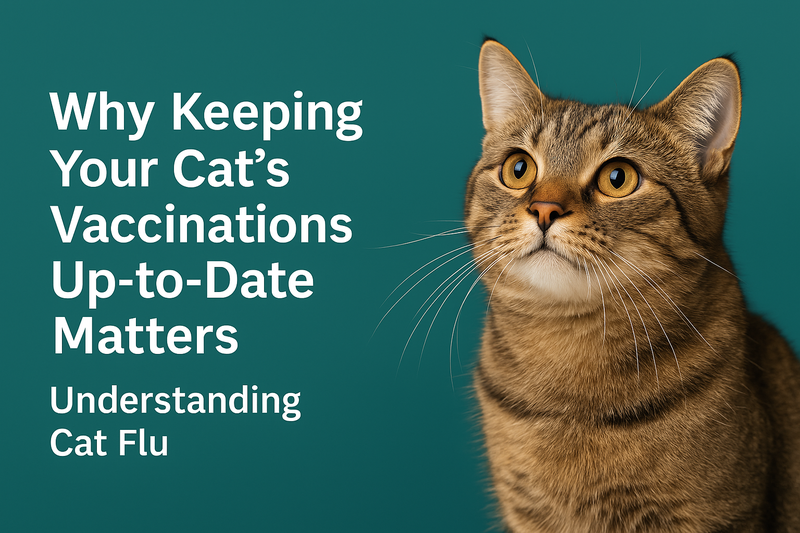After Hours
0408 512 323
Popular Posts
Don’t Let Ear Infections Become a Life-Long Problem for Your Dog: What You Can Do—and How We Can HelpWhy Vet Checks, Vaccinations & Health Screens Matter for Your Pet’s WellbeingWhen Bottoms Go Wrong: Understanding Rectal ProlapseFleas & Worms: What Social Pets Need to Stay Comfortable and HealthyWhat Happens to My Pet During Surgery? A Behind-the-Scenes Look at Eureka Vet Why Keeping Your Cat’s Vaccinations Up-to-Date Matters: Understanding Cat Flu
Why Keeping Your Cat’s Vaccinations Up-to-Date Matters: Understanding Cat Flu
As cat owners, we all want to keep our feline friends healthy, happy, and full of life. One of the most common (and preventable) health challenges we see—especially during winter and boarding season—is cat flu.
At Eureka Veterinary Clinic, we regularly help worried owners manage this condition. In this blog, we’ll explain what cat flu is, what happens if your cat gets it, the risks involved, and why vaccination is your cat’s best defence—especially before boarding.
What Is Cat Flu?
Despite the name, cat flu isn’t the same as human flu, and it can’t pass between cats and people. But just like human flu, it spreads easily between cats—especially in multi-cat homes, shelters, and catteries.
Cat flu refers to a group of highly contagious viruses and bacteria that cause respiratory and eye infections. The main culprits are:
- Feline Herpesvirus (FHV-1): Causes sneezing, nasal discharge, eye infections, and ulcers. Once infected, cats carry this virus for life and can have flare-ups during times of stress.
- Feline Calicivirus (FCV): Causes respiratory signs and mouth ulcers, and in some strains, joint pain or more severe systemic illness.
- Other bacterial infections (like Chlamydophila felis or Bordetella bronchiseptica) can make the illness worse.
How Is Cat Flu Spread?
Cat flu spreads quickly through:
- Sneezing and airborne droplets
- Eye and nasal discharge
- Shared food and water bowls
- Direct contact (e.g., grooming)
- Humans acting as carriers (on hands or clothing)
Even cats who appear healthy can carry and shed the virus, especially herpesvirus carriers.
What Happens If My Cat Gets Cat Flu?
Cat flu can make your cat very unwell and often requires veterinary care.
Common symptoms include:
- Sneezing
- Runny nose (clear, yellow, or green discharge)
- Watery, red, or sticky eyes
- Fever
- Loss of appetite
- Lethargy
- Mouth ulcers, drooling, or difficulty eating
- Breathing difficulties in severe cases
Kittens, elderly cats, and immune-compromised cats are at greatest risk of complications.
What Are the Risks?
Some of the most serious complications of cat flu include:
- Eye ulcers or permanent eye damage
- Chronic nasal congestion or lifelong breathing problems
- Pneumonia
- Severe dehydration
- Weight loss and anorexia
- Death in extreme cases, especially in kittens
Cats who recover from herpesvirus often remain lifelong carriers, meaning they may have repeat flare-ups during stress (moving house, vet visits, boarding, etc).
What Treatment Is Needed?
There’s no cure for the viruses that cause cat flu. Treatment focuses on supportive care and symptom relief.
This may include:
- Antibiotics: To treat or prevent secondary bacterial infections.
- Eye drops or ointments: To manage conjunctivitis or corneal ulcers.
- Nasal decongestants or saline drops: To help with breathing.
- Antiviral medication (such as famciclovir): In severe herpesvirus cases.
- Appetite stimulants or syringe feeding: For cats that stop eating.
- Pain relief: Particularly if there are mouth ulcers.
- Fluid therapy: For cats who are dehydrated.
- Nebulisation or steam therapy: To ease nasal congestion.
Recovery can take one to two weeks for healthy adult cats, but kittens or frail cats may take longer.
The Importance of Vaccination: Protecting Your Cat from Cat Flu
Vaccination is the single most important thing you can do to reduce your cat’s risk of serious illness from cat flu.
What does the vaccination cover?
Core feline vaccines (known as F3 or higher) protect against:
✅ Feline Herpesvirus (FHV-1)
✅ Feline Calicivirus (FCV)
✅ Feline Panleukopenia (a severe gastrointestinal virus)
Additional vaccines (like for Chlamydophila felis) may be recommended for higher-risk cats.
Why vaccinate even if your cat is indoor-only?
Even indoor cats can be exposed if:
- They have to visit the vet
- They need to go to a cattery
- A new cat joins the household
- You carry the virus into your home on shoes, clothes, or hands
Vaccination reduces the severity of illness, shortens recovery time, and reduces virus shedding, making your cat less contagious to others.
Special Considerations Before Boarding Your Cat
Boarding catteries are high-risk environments for cat flu, even in well-managed facilities. Stress, close quarters, and exposure to other cats increase the chance of infection.
Before booking your cat in for boarding:
✅ Check that your cat’s vaccinations are up to date
Most catteries require proof of vaccination within the last 12 months.
✅ Let the cattery know if your cat has had cat flu in the past
Some cats who are herpesvirus carriers may be more prone to flare-ups in stressful settings like boarding.
✅ Ask about the cattery’s infection control procedures
A good cattery will have strict cleaning, isolation, and monitoring protocols.
✅ Plan ahead
Don’t leave vaccinations until the last minute. It’s best to have your cat fully vaccinated at least two weeks before boarding to give their immune system time to respond.
Our Commitment to Your Cat’s Health
At Eureka Veterinary Clinic, we’ve seen first-hand how distressing cat flu can be for both pets and owners. We strongly encourage all our clients to keep vaccinations up to date and plan early before boarding.
If you’re unsure about your cat’s vaccination status—or you’d like to book your cat in for a booster—please contact us today.
Let’s work together to keep your cat protected, healthy, and ready for their next adventure (whether it’s a cattery stay or just another sunny spot on the couch!).
Book online or give us a call on 03 5333 5959 today. We’d love to see you.
CLICK HERE for available times and bookingsBOOK ONLINE >
Location



